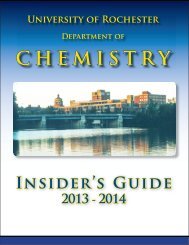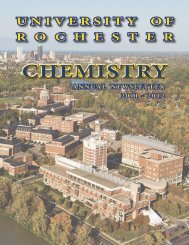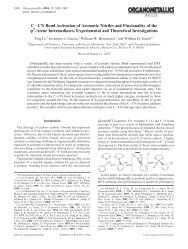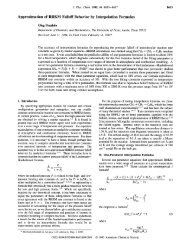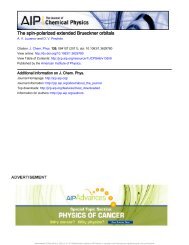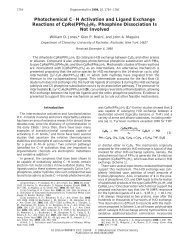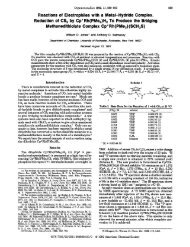Synthesis and Reactivity of New Ni, Pd, and Pt 2, 6-Bis (di-tert ...
Synthesis and Reactivity of New Ni, Pd, and Pt 2, 6-Bis (di-tert ...
Synthesis and Reactivity of New Ni, Pd, and Pt 2, 6-Bis (di-tert ...
You also want an ePaper? Increase the reach of your titles
YUMPU automatically turns print PDFs into web optimized ePapers that Google loves.
Inorganic Chemistry<br />
ARTICLE<br />
Figure 6. Structure <strong>of</strong> <strong>Ni</strong> isocyanide complex. Ellipsoids are shown at<br />
the 50% level.<br />
temperature). To test whether complex 4a catalyzed this hydrosilylation<br />
by insertion <strong>of</strong> aldehyde to the metal hydride bond as<br />
reported in the literature, 3s complex 4a was reacted with benzaldehyde<br />
in the absence <strong>of</strong> silane. No insertion <strong>of</strong> benzaldehyde<br />
was observed after 2 days at room temperature, as confirmed by<br />
1 H NMR spectroscopy (eq 10). When this mixture was heated at<br />
100 °C for 1 h, it decomposed to some paramagnetic complexes<br />
<strong>and</strong> one <strong>di</strong>amagnetic complex. The 31 P NMR spectrum showed<br />
only one signal with low intensity at δ 50.56, <strong>and</strong> the 1 H NMR<br />
spectrum showed broad signals at δ 25.80, 16.53, <strong>and</strong> 9.36 <strong>and</strong><br />
2.49. Crystals were grown by slow evaporation from the hexane<br />
solution <strong>of</strong> this decomposition mixture. X-ray crystallography<br />
provided the structure <strong>of</strong> the <strong>di</strong>amagnetic decomposition product<br />
(Figure 7), showing degradation <strong>of</strong> the PONOP lig<strong>and</strong>.<br />
<strong>Ni</strong>ckel phosphorus <strong>and</strong> nickel carbon <strong>di</strong>stances are comparable<br />
to those in 3a <strong>and</strong> 3a-BPh 4 . This unusual compound is<br />
somewhat reminiscent <strong>of</strong> <strong>Ni</strong>eke’s PNPN macrocycle, 19 although<br />
the pentavalent phosphorus here results in a planar structure<br />
compared with <strong>Ni</strong>eke’s tetravalent phosphorus macrocycle complex<br />
<strong>of</strong> copper, which is folded. 20<br />
Figure 7. Structure <strong>of</strong> <strong>Ni</strong>(c-PONOPONO) from the decomposition <strong>of</strong><br />
product 6. Selected bond <strong>di</strong>stances (Å): <strong>Ni</strong>1 N1, 1.864(4); <strong>Ni</strong>1 P1,<br />
2.233(1); P1 O1, 1.862(3); N1 C1, 1.353(4); C1 C2, 1.395(4);<br />
1.380(4). Ellipsoids are shown at the 50% level.<br />
as determined by the broad range <strong>of</strong> chemical shifts. Consequently,<br />
the mechanism <strong>of</strong> this hydrosilylation reaction catalyzed by<br />
complex 4a remains unknown.<br />
’ CONCLUSIONS<br />
The synthesis <strong>and</strong> characterization <strong>of</strong> new class <strong>of</strong> group 10<br />
metal pincer complexes has been established. The side arm <strong>of</strong><br />
these complexes has no proton to lose in the presence <strong>of</strong> base<br />
(particularly hydride), compared to other known PNP or PNN<br />
pincer complexes. These (PONOP)M (M = <strong>Ni</strong>, <strong>Pd</strong>, <strong>Pt</strong>) complexes<br />
showed some unique properties. When the (PONOP)-<br />
MCl 2 (M = <strong>Ni</strong>, <strong>Pd</strong>, <strong>Pt</strong>) complexes were reacted with 1 equiv <strong>of</strong><br />
superhydride, a new class <strong>of</strong> pincer complex [(H-PONOP)MCl<br />
(M = <strong>Ni</strong>, <strong>Pd</strong>, <strong>Pt</strong>)] formed in which the pyri<strong>di</strong>ne was reduced.<br />
<strong>Reactivity</strong> <strong>of</strong> these complexes toward MeLi was also examined,<br />
<strong>and</strong> (H-PONOP)<strong>Ni</strong>(Me) was prepared. These pincer nickel<br />
complexes catalyzed the hydrosilylation <strong>of</strong> aldehydes, although<br />
the mechanism <strong>of</strong> this reaction was not established. Characterization<br />
<strong>and</strong> crystallization <strong>of</strong> these complexes were <strong>di</strong>fficult in<br />
most <strong>of</strong> the cases, particularly with <strong>Pd</strong> <strong>and</strong> <strong>Pt</strong> metals, because <strong>of</strong><br />
their high instability.<br />
To gain insight into the mechanism more clearly (D-PO-<br />
NOP)<strong>Ni</strong>Cl (4a-d 1 ) was synthesized by reacting complex 3a with<br />
deuterated superhydride (eq 11). Reaction <strong>of</strong> 4a-d 1 with benzaldehyde<br />
<strong>and</strong> PhSiH 3 under similar reaction con<strong>di</strong>tions <strong>di</strong>d not<br />
show deuterium incorporation in the hydrosilylation products. It<br />
is not clear how this reaction proceeds, but a ra<strong>di</strong>cal pathway is<br />
possible, although there is no <strong>di</strong>rect evidence for this. When<br />
complex 4a in C 6 D 6 was heated for 30 min at 100 °C, it decomposed,<br />
<strong>and</strong> several paramagnetic complexes <strong>and</strong> one <strong>di</strong>amagnetic<br />
complex were detected by 1 H <strong>and</strong> 31 P NMR spectroscopy,<br />
’ EXPERIMENTAL SECTION<br />
General Procedures <strong>and</strong> Materials. Unless otherwise stated, all<br />
reactions <strong>and</strong> manipulations were carried out in dry glassware using<br />
st<strong>and</strong>ard Schlenk <strong>and</strong> glovebox techniques, under a nitrogen atmosphere.<br />
THF-d 8 , p-xylene-d 10 , <strong>and</strong> C 6 D 6 were purchased from Cambridge<br />
Isotope Laboratories <strong>and</strong> dried using Na/K <strong>and</strong> collected by<br />
vacuum transfer. All other reagents were purchased from Aldrich, Strem,<br />
or VWR chemical company <strong>and</strong> used without any further purification.<br />
All NMR spectra were recorded on Bruker Avance 400 <strong>and</strong> 500 MHz<br />
spectrometers. 31 P NMR chemical shifts (δ in ppm) are relative to an<br />
external 85% solution <strong>of</strong> H 3 PO 4 in the appropriate solvent. Elemental<br />
9448 dx.doi.org/10.1021/ic201102v |Inorg. Chem. 2011, 50, 9443–9453




